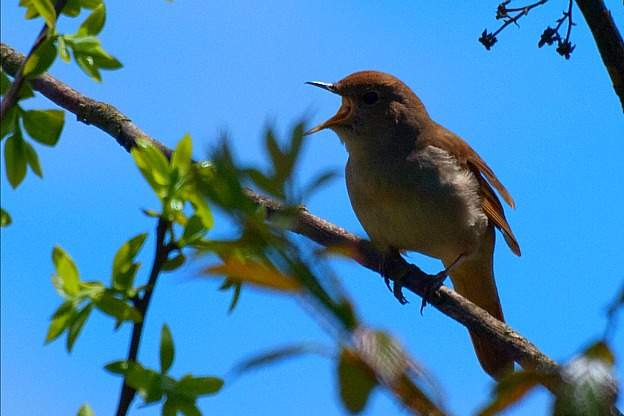
Doves, nightingales, ravens, and birds of all sorts-their songs have long sparked the imaginations of musicians. Coming up, we'll hear music inspired by birdsongs! We'll also explore the art of the fantasia and hear examples from different regions of Europe.
Let's begin with François Couperin's Les fauvetes plaintives, performed by Frederick Haas.
Fancy fantasias
Imagine a lutenist [lute player]… Imagine how he cradles his instrument in his arms. Imagine his fingers as they fly over the strings, free to roam as they will.
This is the art of the fantasia: an instrumental composition with roots deeply embedded in the practice of improvisation. The fantasia was once described by Luis de Milán as a "composition whose form and invention spring ‘solely from the fantasy and skill of the author who created it.'"
Not all fantasias were intended for a solo instrument. Fantasias for viol consort became hugely popular during the Renaissance. Here's one example, from Spain.
In contrast, how about this French fantaisie, this time for a solo viola da gamba?
Thus far, we've heard three different fantasias from three different countries. There was the fantasia for solo lute from Italy, followed by the one for viol consort from Spain, and the one for solo viola da gamba from France. But what about England?
Thomas Tomkins was born in 1572 in Pembrokeshire. His charming tune "Fancy for Two to Play" is intended for two players, four hands all in all, to be played on just one keyboard.
Taking flight
Birds…large or small, red, green, blue, or brown…these feathered, clawed, "poets of the sky" have served as sources of inspiration to musicians for as long as musicians have made melody. Birds are, perhaps, the original songsters. Many hearts have been moved by the cheerful warbling of a lark or the plaintive song of the nightingale.
Many aspects of our modern life would appear completely foreign to the French troubadour Bernart de Ventadorn, who died around 1200. Computers, cars, and many other conveniences would surely baffle him. However, if he were to look to the skies, he might find some comfort in familiarity! His song Quan vei la lauzeta mover, or, "When I see the lark beat his wings," laments the anxiety and pain of unrequited love…surely a feeling that is not so foreign to many of us!
If the song of the cheerful lark is a common symbol of joy, then the cooing of the mournful dove is, perhaps, one of our most recognizable symbols of pain. George Frideric Handel recognized this when he composed the aria "As when the dove," for his 1718 Acis and Galatea. In this aria, Galatea sings of her pain at being separated from her beloved.
We've already heard from the lovely lark, the doleful dove…and now for the mysterious nightingale.
In the third volume of his 1722 Pièces de clavecin, François Couperin included a whole ordreof pieces inspired by birdsong. The mysterious nightingale, the little linnet, the elusive warbler…they're all there. We'll hear Le rossignol-en-amour, or "The nightingale in love," performed by Frans Brüggen on the recorder and Gustav Leonhardt on the harpsichord.
Featured: Alfred Deller and bird-themed songs
On our featured release, we continue our birdsong theme as we take a look back at the work of English countertenor Alfred Deller. Deller, who was born in 1912, got his start in the church.
While employed as a member of the alto section of the choir of Canterbury Cathedral, he came to the attention of the composer Michael Tippett, who launched Deller's early music career. Deller went on to become the first countertenor to rise to fame on the international stage in over two hundred years, paving the way for the hundreds of contemporary countertenors who have followed in his footsteps.
More flights of fancy: we heard bird-themed English folk songs and ballads, performed by the groundbreaking English countertenor Alfred Deller and the Deller Consort… from a 2008 seven-disc compilation called Alfred Deller: The Complete Vanguard Classics Recordings - Folk Songs and Ballads.
Break and Theme music
:30, John Jenkins: Fantasias, Pavans & Airs in Four Parts, The Spirit of Gambo, Pavane Records 2013, Tr. 7: Fantasia I, in C (excerpt of 4:06)
:60, Henry Purcell: Fantazias & In Nomines, Les Basses Réunies, agOgique 2012, Tr. 6: Fantazia Upon One Note (excerpt of 2:47)
:30, An English Fancy, Trio Settecento, Cedille Records 2012, Matthew Locke, "For Several Friends," Suite in B-flat Major, Tr. 17: Fantazie (excerpt of 1:15)
Theme:Â Danse Royale, Ensemble Alcatraz, Elektra Nonesuch 79240-2 1992 B000005J0B, T.12: La Prime Estampie Royal
The writer for this edition of Harmonia is Elizabeth Clark.
Learn more about recent early music CDs on the Harmonia Early Music Podcast. You can subscribe on iTunes or at harmonia early music dot org.









